ZF Friedrichshafen AG has achieved increased sales during the 2018 financial year. The group’s sales increased – adjusted for exchange rate effects and M&A activities – by approximately 6% to EUR 36.9 billion (prior year: EUR 36.4 billion). The adjusted EBIT amounted to EUR 2.1 billion (prior year: EUR 2.3 billion). The adjusted EBIT margin was 5.6% (prior year: 6.4%). At the end of December, ZF employed 148,969 staff worldwide (prior year: 146,148). With its Next Generation Mobility strategy, ZF is pursuing the vision of providing people with safe, clean, and affordable mobility.
“We are shaping the rapidly advancing transformation of the mobility industry to provide our customers with convincing system solutions for next generation mobility. Our results show that we are well positioned for the challenges of the future,” said Wolf-Henning Scheider, CEO of ZF Friedrichshafen AG, at the presentation of the annual results in Friedrichshafen this week. To continue its technology leadership, ZF increased its expenditure in research & development (R&D) in 2018 by an additional 11%. Adjusted for accounting changes, ZF spent a total of EUR 2.5 billion (prior year: EUR 2.2 billion) on R&D; this corresponds to an R&D cost ratio of 6.7%. 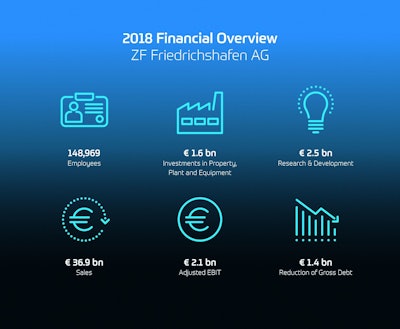
Focus on Mobility and Transport Services
In the booming sector of “Mobility/Transport as a Service,” ZF is creating new mobility products such as the e.GO People Mover. This electrically powered minibus, which will be fitted with autonomous-driving features in the future, will be on the road in the first test fleets in Aachen and Friedrichshafen in the fall. A few weeks ago, ZF also announced the majority stake in 2getthere, a Dutch supplier of autonomous electric passenger transport systems. “The investment was an important step for us as 2getthere has more than 30 years of experience in the autonomous passenger transport market as well as unique engineering and software skills,” added Scheider. The automated guided vehicles from 2getthere have already transported more than 14 million passengers in several major cities, harbors, and airports around the world – wholly electrically, reliably, and profitably. The long-standing experience means the availability of the 2getthere mobility systems is over 99.7%.
Long-Term Success Thanks to Hybrid Transmissions
As well as new mobility solutions, ZF is also further developing its successfully established products such as the 8-speed automatic transmission for passenger cars – primarily through electrification. This week, ZF signed a supply contract with BMW AG for its enhanced 8-speed automatic transmission including a hybrid variant.. The long-term contract represents the largest order of automatic transmissions in the history of the company, confirming the importance of hybrid technology for future individual mobility.
In terms of electrification, ZF’s electrical central drive for passenger cars will also start production with a vehicle manufacturer this year. Furthermore, there is strong demand for its electrical portal axle for city buses which is already successfully established in the market. ZF has won several new orders from bus manufacturers. “ZF has made e-buses marketable in Europe,” said Scheider.
Planned Acquisition of WABCO Strengthens Commercial Vehicle Division
Another important step for ZF is the planned acquisition of WABCO. “The planned takeover is part of our strategy and expands the company’s competence in commercial vehicle braking for the first time,” said Scheider. “We will be able to provide our customers with comprehensive system solutions for the safe and automated transport of passengers and goods.” Last week, ZF announced the takeover of WABCO – a globally leading supplier of braking control systems, technologies, and services for the enhancement of safety, efficiency, and networking of trucks, buses, and trailers – for USD 136.50 per share. This corresponds to a total value of around USD 7 billion. The takeover is expected to be concluded early next year and will help make ZF less dependent in the long term on the cycles of the passenger vehicle market. WABCO employs approximately 16,000 people worldwide and reported sales of EUR 3.2 billion last year.
Structural Changes Make ZF Faster
To enable a faster and more direct response to different market requirements, ZF introduced a dual operating system, which supports various speed and organization models. As part of this process, the previous Active & Passive Safety Technology Division will be divided into three Divisions: Passive Safety Systems, Active Safety Systems, and Electronics and Advanced Driver Assistance Systems (ADAS). To these, system and project centers will be added, driving cross-divisional topics like automated driving or electromobility. “These new structures and processes simplify our hierarchies and complexity. We can react faster and serve our customers even better,” said Schneider.
Solid Economic Development
With a result of EUR 36.9 billion (prior year: EUR 36.4 billion), ZF exceeded its sales projection of EUR 36.5 billion for 2018. Compared to 2017, sales increased nominally by 1.3%. Adjusted for exchange rate effects and M&A activities, sales grew organically by around 6 percent and thus outperformed the market. The Commercial Vehicle Technology (plus 12%) and Industrial Technology (plus 13%) Divisions, in particular, recorded above-average organic sales growth.
The adjusted EBIT of EUR 2.1 billion (prior year: EUR 2.3 billion) is substantially influenced by the increase in expenditure for R&D, increased material prices, adverse exchange rate effects, and a weakening market environment. The adjusted EBIT margin was 5.6%; the free cash flow adjusted for corporate acquisitions and sales was EUR 0.9 billion.
ZF has continued to reduce its liabilities incurred from the TRW acquisition. “In the fiscal year just ended, we reduced the gross debt by EUR 1.4 billion to EUR 5.0 billion, further strengthening our company’s financial independence,” said ZF Chief Financial Officer Dr. Konstantin Sauer. “With an equity ratio of 28%, ZF has a solid economic foundation.” At the end of 2017, the equity ratio was only 24%.
Slight Increase in Number of Employees
On December 31, 2018, ZF employed 148,969 staff worldwide (prior year: 146,148). Additional positions have been created as a consequence of the expansion especially in the areas of automated driving and electromobility, primarily in the North America and Asia-Pacific regions. Worldwide, more than 17,000 employees are working on R&D projects.
Market Environment Remains Tense
Ongoing uncertainties in the political and economic development of many countries, as well as new regulatory frameworks for emission legislation continue to create a tense and challenging environment worldwide. Considering the expected development of the market, and assuming constant exchange rates, ZF expects group sales in 2019 of between EUR 37 billion and EUR 38 billion. ZF is targeting an adjusted EBIT margin of between 5.0 and 5.5%, as well as a free cash flow adjusted for corporate acquisitions and sales of around EUR 1 billion. “Our broad product portfolio, trendsetting technical concepts, and our network make us an attractive systems supplier for our customers; together we can pave the way for the mobility of the next generation,” said Scheider.



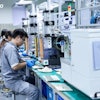
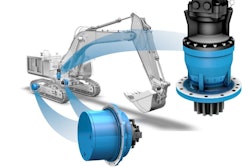
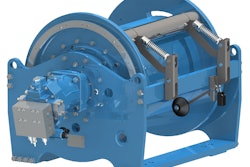

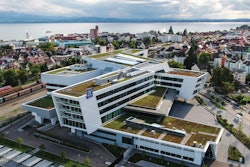









![Sa P75 I Sahr[80]](https://img.oemoffhighway.com/mindful/acbm/workspaces/default/uploads/2025/10/sa-p75-isahr80.Cn3n79HB4H.jpg?ar=16%3A9&auto=format%2Ccompress&fit=crop&h=135&q=70&w=240)